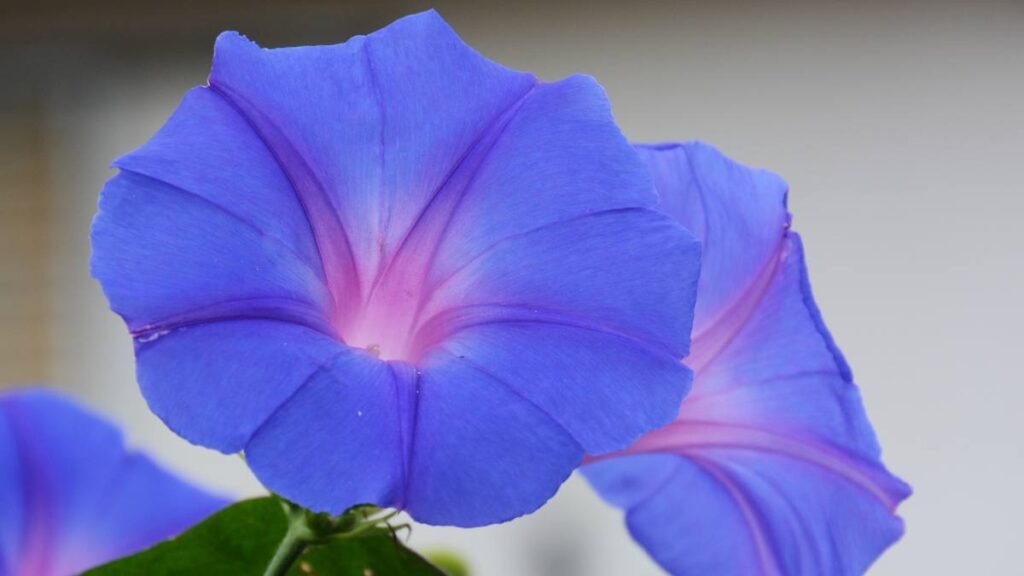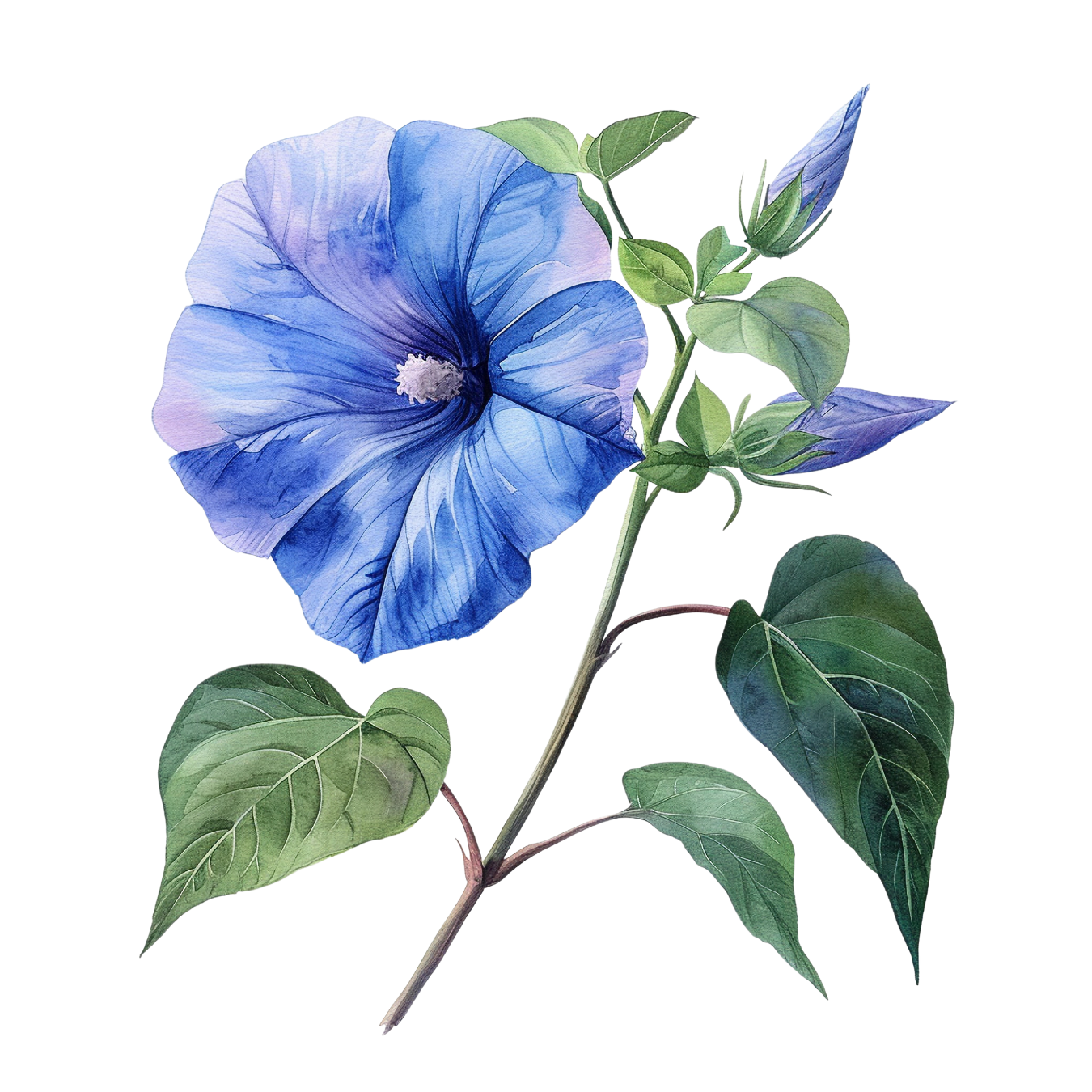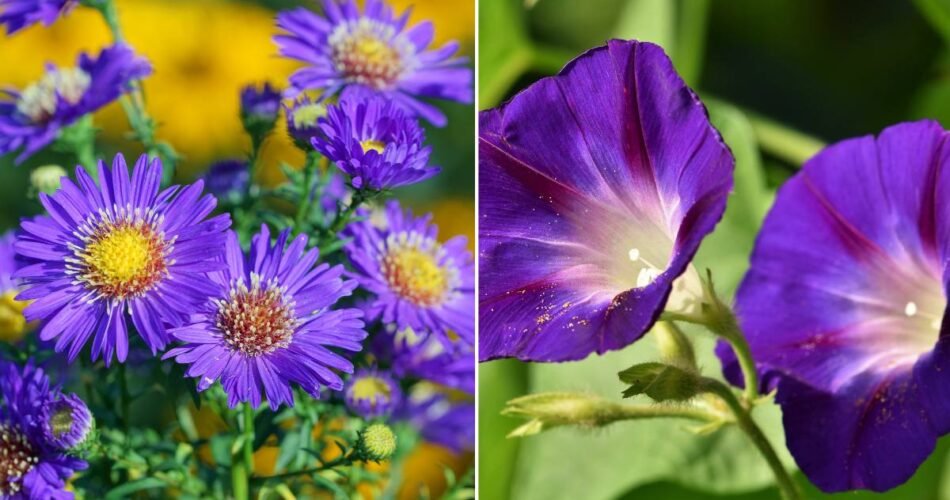What are the September birth flowers?
September is adorned with two captivating birth flowers: Asters and Morning Glories. Asters, with their star-shaped flowers, symbolize love, wisdom, and valor, reflecting the depth and complexity of this transition month. Morning Glories, known for their vibrant trumpet-shaped blooms that open in the morning and close by the afternoon, represent affection, unrequited love, and the fleeting nature of life.
In this blog post, we will delve into the fascinating world of birth month flowers, explore their meanings, origins, and fascinating facts. We will also discover how these flowers inspire art, creativity, and thoughtful gift ideas. So, let’s embark on this journey and uncover the beauty and meaning of September birth month flowers.
Related Post: Birth Flowers for all 12 months
History & Origin of Asters

Asters (Aster spp.), deriving their name from the Greek word for “star,” due to the shape of their flowers, have been cherished across cultures and continents for their beauty and symbolism. With their rich history dating back to ancient Greece, Asters were believed to have been created from the tears of the Greek goddess, Astraea, symbolizing the sadness of the end of summer.
The association of Asters with September comes from their peak blooming period in late summer and early autumn, making them a beacon of the season’s change. In folklore, Asters are often considered talismans of love and a symbol of patience, reflecting the balance between the end of one season and the beginning of another.
What does Asters mean?
Asters are not just known for their beauty but also for their rich symbolism:
- Love and Admiration: Asters are often given as symbols of love, reflecting admiration and a deep appreciation for the recipient.
- Wisdom: The flower is also associated with wisdom, making it a thoughtful gift for someone embarking on a new journey or facing a decision.
- Valor: Reflecting the flower’s robust nature, Asters symbolize courage and strength in the face of challenges.
Different colors of Asters carry specific meanings:
- Purple Asters signify royalty and wisdom, making them a noble choice.
- White Asters represent purity and innocence, often used in bouquets to convey new beginnings.
- Pink Asters convey sensitivity and love, perfect for expressing affection.



How to care for Asters
Asters, with their daisy-like blooms, can be a delightful addition to any garden if given the proper care:
- Sunlight: Asters thrive in full sun but can tolerate partial shade. Ensure they receive at least 6 hours of sunlight daily for optimal growth and flowering.
- Soil: Plant Asters in well-draining soil. They prefer loamy or sandy soil that’s rich in organic matter.
- Watering: Keep the soil consistently moist but not waterlogged. Asters require regular watering, especially during dry spells.
- Pruning: Deadheading spent blooms encourages further flowering and keeps the plant looking tidy. Cutting back the foliage in late autumn helps prepare the plant for winter.
- Disease Prevention: Asters can be susceptible to powdery mildew. Ensure good air circulation around the plants and avoid overhead watering to minimize the risk.
Interesting or less known facts about Asters
- Cosmic Connection: Asters are believed to have been named after the stars due to their star-shaped flowers and their role in various myths related to the heavens and celestial bodies.
- Butterfly Attractors: Asters are an important source of nectar for butterflies, especially in the late summer and fall when other flowers may have finished blooming.
- Historical Use: In ancient times, Asters were believed to ward off serpents and evil spirits. Burning Aster leaves was thought to drive away snakes.
- Victorian Language of Flowers: In the Victorian era, Asters were symbols of patience and daintiness, often used in bouquets to convey these sentiments subtly.
History & Origin of Morning Glories

Morning Glories (Ipomoea spp.), known for their vibrant, trumpet-shaped flowers, have a history that spans many cultures and continents. The name “Morning Glory” refers to the flower’s habit of blooming in the morning and closing by the afternoon. Native to tropical and subtropical regions of the Americas, these flowers were cultivated in China for medicinal purposes as early as the 9th century.
The link between Morning Glories and September can be attributed to their peak blooming period, which often extends into the early fall, providing a burst of color as many other flowers begin to fade. In various cultures, Morning Glories symbolize affection, unrequited love, and the fleeting nature of life, mirroring the transient beauty of the early morning hours.
What does Morning Glories mean?
Morning Glories are rich in symbolism, varying by color:
- Blue Morning Glories represent trust, respect, and a longing for tranquility.
- Red Morning Glories convey a strong sense of love and affection, often associated with deep emotions.
- White Morning Glories symbolize purity and innocence, reflecting new beginnings and fresh starts.
- Pink Morning Glories are tied to gentleness, romance, and a tender heart.



Overall, Morning Glories embody the concept of fleeting beauty and the transient nature of life, reminding us to cherish each moment.
How to care for Morning Glories
Morning Glories, with their twining vines and vibrant blooms, are relatively easy to grow and care for:
- Sunlight: These flowers thrive in full sun, requiring at least 6 hours of direct sunlight each day to bloom profusely.
- Soil: Morning Glories aren’t picky about soil but prefer it to be well-draining. They can do well in average to poor soils, making them perfect for areas where other plants might struggle.
- Watering: Water Morning Glories regularly, especially during dry periods, to keep the soil moist but not waterlogged. Once established, they are somewhat drought-tolerant.
- Support: Provide a structure for Morning Glories to climb, such as trellises, fences, or strings, to encourage vertical growth and enjoy their full beauty.
- Pruning: While not necessary for the health of the plant, occasional pruning can help control their growth and encourage bushier vines.
Interesting or less known facts about Morning Glories
- Medicinal Uses: In traditional medicine, various parts of the Morning Glory plant have been used to treat ailments such as headaches and indigestion. However, caution is advised as some species can be toxic.
- Symbol of Love: In Japanese culture, Morning Glories, or “Asagao,” have been used as a symbol of love in literature and art, often depicted in the famous Edo-period woodblock prints.
- Rapid Growth: Morning Glories are known for their rapid growth and vigorous climbing habit, capable of covering a trellis or fence in just one season.
- Seed Variability: The seeds of some Morning Glory varieties, particularly Ipomoea tricolor, contain compounds that, when ingested, can have psychoactive effects, leading to their use in traditional rituals in some cultures.
September Birth Flower Comparison
| Month | Birth Flower | Characteristics | Symbolism |
|---|---|---|---|
| September | Aster | Daisy-like flowers, a range of colors including blue, white, and pink | Wisdom, valor, faith |
Morning Glory | Bright, trumpet-shaped flowers, opens in the morning | Affection, unrequited love |
What are the popular September birth flower gifts?
Asters and Morning Glories, September’s birth flowers, offer a variety of gifting options that capture the spirit of the season:
- Floral Arrangements: Combine the dainty Asters with the climbing beauty of Morning Glories in a bouquet or arrangement to celebrate September birthdays or other special occasions.
- Garden Gifts: Offer Aster plants or Morning Glory seeds as gifts, allowing loved ones to cultivate these beautiful flowers in their own gardens.
- Themed Artwork: Choose or commission artwork featuring Asters or Morning Glories, such as paintings, prints, or digital art, for a lasting tribute to September’s birth flowers.
- Decorative Items: Look for decorative items like candles, stationery, or home textiles adorned with Aster or Morning Glory motifs for a subtle nod to the recipient’s birth month.
Here are some more gift ideas featuring September’s birth flowers to explore.












What are some artistic or creative applications of September birth flower gifts?
Asters and Morning Glories can be beautifully incorporated into various artistic and creative projects:
- Botanical Art: These flowers can serve as stunning subjects for botanical illustrations, watercolor paintings, or photography, capturing their unique beauty and detail.
- DIY Crafts: Use Aster and Morning Glory motifs in DIY crafts such as handmade cards, scrapbooking, or fabric printing to add a personal touch to gifts and decorations.
- Fashion Design: Incorporate floral patterns inspired by Asters and Morning Glories into fashion design, creating unique garments, scarves, or bags that reflect the beauty of September.
- Tattoo Art: Asters and Morning Glories can be translated into delicate and meaningful tattoo designs, symbolizing the traits and sentiments associated with these flowers.
Conclusion
September’s birth flowers, Asters and Morning Glories, offer a rich tapestry of symbolism and beauty, reflecting the complexity and depth of this transitional month. From the star-shaped blooms of Asters to the twining vines of Morning Glories, these flowers remind us of nature’s resilience and the cycles of growth and renewal. Embracing these floral symbols, whether in gardens, bouquets, or artistic expressions, allows us to connect with the essence of September and celebrate the unique qualities of those born during this month.
10 FAQs
What are the birth flowers for September?
Asters and Morning Glories.
What do Asters symbolize?
Love, wisdom, and valor.
What is the meaning behind Morning Glories?
Affection, unrequited love, and the fleeting nature of life.
Can Asters be grown indoors?
Asters are best suited for outdoor gardens but can be enjoyed indoors as cut flowers.
How long do Morning Glory flowers last?
Each bloom typically opens in the morning and closes by the afternoon, lasting just one day.
Are Asters perennials or annuals?
Asters include both perennial and annual varieties.
Do Morning Glories attract wildlife?
Yes, they attract bees, butterflies, and hummingbirds.
How often should I water Asters?
Keep the soil consistently moist, especially during dry spells.
Can Morning Glories be invasive?
Some varieties can be aggressive and may require management to prevent them from overtaking other plants.
What colors do Asters come in?
Asters bloom in a range of colors, including purple, blue, white, and pink.

